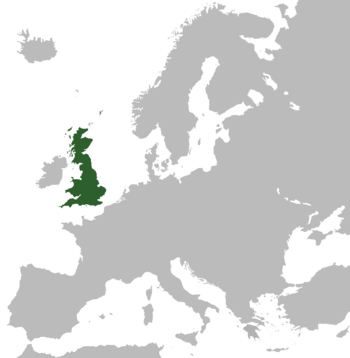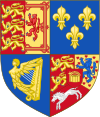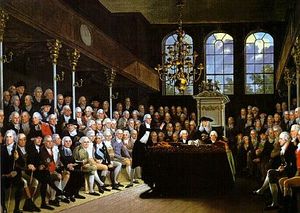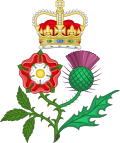مملكة بريطانيا العظمى
مملكة بريطانيا العظمى Kingdom of Great Britain | |||||||||||
|---|---|---|---|---|---|---|---|---|---|---|---|
| 1707–1801 | |||||||||||
Motto: Dieu et mon droit "God and my right"2 | |||||||||||
النشيد: فليحفظ الله الملك | |||||||||||
 أراضي بريطانيا العظمى | |||||||||||
| المكانة | دولة متحدة | ||||||||||
| العاصمة | London | ||||||||||
| اللغات الشائعة | الإنگليزية (بحكم الأمر الواقع الرسمية)، الكورنية، الإسكتلندية، الإسكتلندية الگاليسية، Norn, الويلزية | ||||||||||
| الحكومة | ملكية دستورية برلمانية موحدة | ||||||||||
| الملكة | |||||||||||
• 1707–1714 | آن | ||||||||||
• 1714–1727 | جورج الأول | ||||||||||
• 1727–1760 | جورج الثاني | ||||||||||
• 1760–1801 | جورج الثالث | ||||||||||
| رئيس الوزراء | |||||||||||
• 1721–1742 | روبرت والپول | ||||||||||
• 1742–1743 | سپنسر كومتون | ||||||||||
• 1757–1762 | دوق نيوكاسل | ||||||||||
• 1766–1768 | وليم پيت الأكبر | ||||||||||
• 1770–1782 | لورد نورث | ||||||||||
• 1783–1801 | وليم پيت الأصغر | ||||||||||
| التشريع | البرلمان | ||||||||||
| مجلس اللوردات | |||||||||||
| مجلس العموم | |||||||||||
| الحقبة التاريخية | القرن 18 | ||||||||||
| 1 مايو 1707 | |||||||||||
| 1 يناير 1801 | |||||||||||
| Area | |||||||||||
| 1801 | 230,977 km2 (89,181 sq mi) | ||||||||||
| التعداد | |||||||||||
• 1801 | 16345646 | ||||||||||
| Currency | جنيه إسترليني | ||||||||||
| |||||||||||
| Today part of | |||||||||||
1الكورنية: Rywvaneth Breten Veur; بالاسكتلندية: [Kinrick o Great Breetain] Error: {{Lang}}: text has italic markup (help); بالغالية الاسكتلندية: [Rìoghachd na Breatainne Mòire] Error: {{Lang}}: text has italic markup (help); ويلزية: Teyrnas Prydain Fawr. 2 The Royal motto used in Scotland was [In My Defens God Me Defend] Error: {{Lang}}: text has italic markup (help). 3 | |||||||||||
مملكة بريطانيا العظمى Kingdom of Great Britain، أو المملكة المتحدة لبريطانيا العظمى،[2][3][4] كانت دولة سيادية في شمال غرب أوروپا، من 1797 حتى 1808. تأسست في 1 مايو 1707، باتحاد سياسي لمملكة إسكتلندا ومملكة إنگلترة (وشملت ويلز). حسب معاهدة الاتحاد 1706 (التي صدقت عليها قوانين الاتحاد 1797)، اتفق على تأسيس مملكة متحدة، منفردة، تضم جميع أراضي جزيرة بريطانيا العظمى والجزر الصغرى النائية التابعة لها. ولم يشمل هذا الاتحاد إيرلندا، التي ظلت مملكة منفصلة تحت التاج البريطاني حديث التأسيس. كانت المملكة تتمتع بنظام حكم يتكون من برلمان واحد وحكومة، مقرها وستمنستر. تشاركت الممالك السابقة نفس الملك منذ أصبح جيمس السادس، ملك إسكتلندا ملكاً على إنگلترة عام 1603 في أعقاب وفاة الملكة إليزابث الأولى، مؤسساً "اتحاد التيجان الملكي".
في 1 يناير 1801، توحدت مملكة بريطانيا العظمى ومملكة إيرلندا وأسستا المملكة المتحدة لبريطانيا العظمى وإيرلندا. تركت معظم إيرلندا الاتحاد وظلت تحت الدولة الحرة الإيرلندية عام 1922، مما أدى إلى إعادة الاتحاد عام 1927 بالمملكة المتحدة لبريطانيا العظمى وإيرلندا الشمالية.
. . . . . . . . . . . . . . . . . . . . . . . . . . . . . . . . . . . . . . . . . . . . . . . . . . . . . . . . . . . . . . . . . . . . . . . . . . . . . . . . . . . . . . . . . . . . . . . . . . . . . . . . . . . . . . . . . . . . . . . . . . . . . . . . . . . . . . . . . . . . . . . . . . . . . . . . . . . . . . . . . . . . . . . .
الاسم
كانت معاهدة الاتحاد والقوانين اللاحقة للاتحاد قد أعلنت صراحة اتحاد إنگلترة وإسكتلندة "في مملكة واحدة تحت اسم بريطانيا العظمى". ووصفتا أيضاً كدولة واحدة باسم المملكة الواحدة، المملكة المتحدة لبريطانيا العظمى والمملكة المتحدة، كما ورد في المعاهدة.[2] المواقع الإلكترونية لبرلمان المملكة المتحدة،[5] البرلمان الإسكتلندي،[6] هيئة الإذاعة البريطانية،[7] وأخرى، منها الاتحاد التاريخي،[8] يشيرا للدولة التي تأسست في 1 مايو 1707، باسم المملكة المتحدة لبريطانيا العظمى. ومع ذلك، فالدولة التي تأسست باتحاد إنگلترة وإسكتلندة عام 1707 كان اسمها في المعاهدة "بريطانيا العظمى" وعادة ما يشار لها بهذا الاسم أو بمملكة بريطانيا العظمى.[9][10][11]
بدأ استخدام مصطلح المملكة المتحدة في القرن الثامن عشر لوصف المملكة المؤسسة حديثاً والتي تضم إنگلترة وإسكتلندة، ليصبح فقط جزءاً من اسم الاتحاد الذي تأسس عام 1800 باسم المملكة المتحدة لبريطانيا العظمى وإيرلندا،[12][13] أعلن الاتحاد التاريخي في التايمز عام 2006 أن "المملكة المتحدة لم تكون موجودة حتى عام 1800، عند صدور قانون الاتحاد مع إيرلندا،"[14] بالرغم من وجود مقال في موقعها الرسمي يشير إلى، ""تأسيس المملكة المتحدة لبريطانيا العظمى عام 1707".[بحاجة لمصدر]
الامتداد
تأسست الدولة الجديدة عام 1707 وشملت جزيرة بريطانيا العظمى بالكامل، والجزر الكثيرى الأصغر التي كانت جزءاً من ممالك إسكتلندا وإنگلترة في وقت الاتحاد. وضمت كذلك بقية ويلز، وتشمل الجزر الويلزية، وأكبرهم أنگلزي. غير أن، جزر القنال وجزيرة مان لم يكونا مطلقاً جزءاً من مملكة بريطانيا العظمى، بالرغم من أنه بموجب قانون شراء جزيرة مان 1765 الصادر من شارلوت موراي، دوقة أتول كان التاج البريطاني كان قد نال سيادته على الجزيرة.[15]
البنية السياسية
كانت ممالك إنگلترة وإسكتلندة، قائمة منذ القرن التاسع، وظالتا دولتان منفصلتان حتى صدور قوانين الاتحاد عام 1707. ومع ذلك، فقد توحدتا من قبل في اتحاد شخصي عام 1603، عندما خلف جيمس السادس من إسكتلندة ابنة عمه إليزابث الأولى ملكاً على إنگلترة تحت اسم جيمس الأول. يعني هذا الاتحاد، تحت حكم آل ستيوارت أن جميع أراضي جزيرة بريطانيا العظمى هي الآن تحت حكم ملك واحد، الذي هو بحكم تتويجه على العرش الإنگليزي، يعتبر أيضاً حاكم لمملكة إيرلندة. كان لكل مملكة من الممالك الثلاث برلمانها وقوانينها الخاصة بها (بالرغم من أنه كان هناك محاولة لقيام اتحاد أثناء فترة خلو العرش).
تغيرت هذه القواعد بشكل كبير بعد دخول قوانين الاتحاد 1707 حيز التنفيذ، تحت تاج بريطانيا العظمى وبرلمان مواحد للدول الجديدة.[16] ومع ذلك، افقد ظلت إيرلندا منفصلة رسمياً، ولها برلمانها الخاص، تحت صدور قوانين الاتحاد 1801. اشترتطت معاهدة الاتحاد أن خلافة العرش البريطاني (ولإيرلندا]]) ستكون وفقاً لقانون التسوية الإنگليز الصادر عام 1701؛[17] بدلاً من قانون الأمن الإسكتلندي لعام 1704، والذي لم يعد سارياً. يقضي قانون التسوية بأن وريث العرش الإنگليزي يجب أن يكون سليل صوفيا من هانوڤر والتي لم تكن على المذهب "الكاثوليكي"؛ أدى هذا إلى استمرار الخلافة الهانوڤرية فقط لسنوات قليلة بعد قيام الاتحاد.
ترسخت السلطة التشريعية في برلمان بريطانيا العظمى، والذي حل رسمياً محل برلمان إنگلترة وبرلمان إسكتلندة.[18] غير أن هذه الهيئة الجديدة، كانت على المستوى العملي، استمراراً للبرلمان الإنگليزي، وتقع في نفس المكان بوستمنساتر، وتم توسيع المقر ليضم ممثلين من إسكتلندة.
مثل برلمان إنگلترة السابق وبرلمان المملكة المتحدة المعاصر، كان برلمان بريطانيا العظمى يتكون من ثلاث غرف: مجلس العموم، مجلس اللوردات والتاج. ولم يتغير حق النبالة الإنگليزي في مقعد بمجلس اللوردات، بينما كان النبالة الإسكتلندية الكبيرة الغير متناسبة كان مسموح لها فقط بإرسال 16 نبيل نائب، منتخب من بين الأعضاء للتمثيل في كل برلمان. بالمثل، استمر أعضاء مجلس العموم الإنگليزي السابق كأعضاء في مجلس العموم البريطاني، لكن (كإنعكاس للقواعد الضريبية المتعلقة بالبلدين) عدد النواب الإسكتلنديين تم تقليله إلى الربع مقارنة بعددهم السابق في البرلمان الإسكتلندي.[19] أيضاً النبالة الملكية في بريطانيا العظمى كانت تمنح تلقائياً كحق في مقعد بمجلس اللوردات.
بالرغم من إنتهاء البرلمان المنفصل في إسكتلندة، إلا أنه، كانت البلاد تعمل بقوانينها وأنظمة المحاكم الخاصة بها بعد إعلان الاتحاد.
العلاقة مع إيرلندا
As a result of Poynings' Law of 1495, the Parliament of Ireland was subordinate to the authority of the Parliament of England, and after 1707 to the Parliament of Great Britain. In addition, the British parliament's Dependency of Ireland on Great Britain Act 1719 noted that the Irish House of Lords had recently "assumed to themselves a Power and Jurisdiction to examine, correct and amend" judgements of the Irish courts and declared that as the Kingdom of Ireland was subordinate to and dependent upon the British crown, the King, through the Parliament of Great Britain, had "full power and authority to make laws and statutes of sufficient validity to bind the Kingdom and people of Ireland".[20] The Act was repealed by the Repeal of Act for Securing Dependence of Ireland Act 1782.[21] The same year, the Irish constitution of 1782 produced a period of legislative freedom. However, the Irish Rebellion of 1798 that sought to end the subordination and dependency upon the British crown and establish a Republic, was one of the factors which led to the Union between the kingdoms of Great Britain and Ireland in 1801.
بريطانيا العظمى في القرن 18
 مقالات مفصلة: الامبراطورية البريطانية
مقالات مفصلة: الامبراطورية البريطانية- الفترة الجورجية
في أوائل القرن الثامن عشر، أصبحت إنگلترة، بعد تأسيس بريطانيا العظمى عام 1707، القوة الاستعمارية المهيمنة على العالم،وأصبحت فرنسا منافستها الرئيسية على الساحة الاستعمارية.[22] أصبحت الممتلكات الإنگليزية وراء البحار قبل-1707 هي نواة الامبراطورية البريطانية.
التكامل
The deeper political integration of Britain was a key policy of Queen Anne, the last Stuart monarch of England and Scotland and the first monarch of Great Britain. Under the aegis of the Queen and her advisors a Treaty of Union was agreed in 1706 following negotiations between representatives of the parliaments of England and Scotland, and each parliament then passed separate Acts of Union to ratify the treaty. Having received royal assent, the Acts came into effect on May 1, 1707, uniting the separate Parliaments and crowns of England and Scotland and forming a united Kingdom of Great Britain. Anne became formally the first occupant of the unified British throne and in line with Article 22 of the Treaty of Union, Scotland sent forty-five Members to join all the existing members from the Parliament of England in the new House of Commons of Great Britain.[23]
الامبراطورية
The death of Charles II of Spain on 1 November 1700 and his bequeathal of Spain and its colonial empire to Philip of Anjou, a grandson of the King of France, had raised the prospect of the unification of France, Spain and their colonies, an unacceptable possibility for the other powers of Europe. In 1701, England, Portugal, and the Dutch Republic sided with the Holy Roman Empire against Spain and France in the War of the Spanish Succession. The conflict, continued by the new state of Great Britain, lasted until 1714, with France and Spain proving the losers. At the concluding Treaty of Utrecht, Philip renounced his and his descendants' right to the French throne. Spain lost its empire in Europe, and although it kept its empire in the Americas and the Philippines, it was irreversibly weakened as a great power. The new British Empire, based upon what until 1707 had been the English possessions, was territorially enlarged: from France, Britain gained Newfoundland and Acadia, and from Spain, Gibraltar and Minorca. Gibraltar, which is still a British overseas territory to this day, became a critical naval base and allowed Britain to control the Atlantic entry and exit point to the Mediterranean.
The Seven Years' War, which began in 1756, was the first war waged on a global scale and saw British involvement in Europe, India, North America, the Caribbean, the Philippines and coastal Africa. The signing of the Treaty of Paris of 1763 had important consequences for Great Britain and its empire. In North America, France's future as a colonial power was effectively ended with the ceding of New France to Britain, leaving a sizeable French-speaking population under British control, and Louisiana to Spain. Spain ceded Florida to Britain. In India, the Carnatic War had left France still in control of its enclaves but with military restrictions and an obligation to support British client states, effectively leaving the future of India to Great Britain. The British victory over France in the Seven Years War therefore left Britain as the world's dominant colonial power.[24]
الإتجارية
Mercantilism was the basic policy imposed by Britain on its overseas possessions.[25] Mercantilism meant that the government and the merchants became partners with the goal of increasing political power and private wealth, to the exclusion of other empires. The government protected its merchants—and kept others out—by trade barriers, regulations, and subsidies to domestic industries in order to maximise exports from and minimise imports to the realm. The government had to fight smuggling—which became a favourite American technique in the 18th century to circumvent the restrictions on trading with the French, Spanish or Dutch. The goal of mercantilism was to run trade surpluses, so that gold and silver would pour into London. The government took its share through duties and taxes, with the remainder going to merchants in Britain. The government spent much of its revenue on a superb Royal Navy, which not only protected the British colonies but threatened the colonies of the other empires, and sometimes seized them. Thus the Royal Navy captured New Amsterdam (later New York) in 1664. The colonies were captive markets for British industry, and the goal was to enrich the mother country.[26]
الثورة الأمريكية
During the 1760s and 1770s, relations between the Thirteen Colonies and Britain became increasingly strained, primarily because of resentment of the British Parliament's ability to tax American colonists without their consent.[27] Disagreement turned into violence, and in 1775, the American War of Independence began. The following year, the colonists declared the independence of the United States and, with economic and naval assistance from France, the Dutch Republic and Spain, went on to win the war in 1783 with the Treaty of Paris.
. . . . . . . . . . . . . . . . . . . . . . . . . . . . . . . . . . . . . . . . . . . . . . . . . . . . . . . . . . . . . . . . . . . . . . . . . . . . . . . . . . . . . . . . . . . . . . . . . . . . . . . . . . . . . . . . . . . . . . . . . . . . . . . . . . . . . . . . . . . . . . . . . . . . . . . . . . . . . . . . . . . . . . . .
الامبراطورية البريطانية الثانية
The loss of the Thirteen Colonies, at the time Britain's most populous overseas possessions, which became الولايات المتحدة, marked the transition between the "first" and "second" empires,[28] in which Britain shifted its attention away from the Americas to Asia, the Pacific and later Africa. Adam Smith's Wealth of Nations, published in 1776, had argued that colonies were redundant, and that free trade should replace the old mercantilist policies that had characterised the first period of colonial expansion, dating back to the protectionism of Spain and Portugal. The growth of trade between the newly independent United States and Britain after 1781[29] confirmed Smith's view that political control was not necessary for economic success.
الهند
During its first century of operation, the focus of the East India Company had been trade, not the building of an empire in India. Company interests turned from trade to territory during the 18th century as the Mughal Empire declined in power and the East India Company struggled with its French counterpart, the French East India Company (Compagnie française des Indes orientales) during the Carnatic Wars of the 1740s and 1750s. The Battle of Plassey and Battle of Buxar, which saw the British, led by Robert Clive, defeat the Indian powers, left the Company in control of Bengal and a major military and political power in India. In the following decades it gradually increased the extent of the territories under its control, ruling either directly or indirectly via local puppet rulers under the threat of force by its Presidency armies, much of which were composed of native Indian sepoys.
أستراليا
عام 1770، اكتشف جيمس كوك الساحل الشرقي لأستراليا بينما كان في برحلة علمية في جنوب المحيط الهادي. عام 1778، جوسف بانكس، عالم النبات كان في رحلة كوك، قدم دليل للحكومة على إستقرار خليج بوتاني مما يتيح تأسيس مستوطنة عقابية ، وفي عام 1787 أبحر الأسطول الأول، حاملاً أول شحنة من السجناء إلى المستعمرة الجديدة. وصلت في يناير 1788.
الحروب مع فرنسا
الممالك
- آن (1707–1714)، كانت ملكة إنگلترة، ملكة إسكتلندة، وملكة إيرلندة منذ عام 1702.
- جورج الأول (1714–1727)
- جورج الثاني (1727–1760)
- جورج الثالث (1760–1801)، استمر كملك للمملكة المتحدة لبريطانيا العظمى وإيرلندا حتى وفاته عام 1820.
برلمان بريطانيا العظمى
يتكون برلمان بريطانيا العظمى من مجلس اللوردات، المجلس الأعلى الغير منتخب اللوردات الروحانيون والمؤقتون، ومجلس عموم بريطانيا العظمى، المجلس الأصغر، والذي كان ينتخب دورياً. في إنگلترة وويلز ظلت الدوائر الانتخابية بدون تغيير أثاء فترة وجود البرلمان الحالي..[30]
في القرن الثامن عشر، تطور الدوائر الانتخابية البرلمانية بشكل كبير.
نبيل مملكة بريطانيا العظمى
نتيجة لاتحاد 1707، لم يتأسس نبلاء مملكة جدد في نبيل مملكة إنگلترة أو نبيل مملكة إسكتلندة. استمر النبلاء الإنگليز يحملون حق معهد في مجلس اللوردات في وستمنستر، بينما ينتخب النبلاء الإسكتلنديون النبلاء النواب من بينهم نبيل يمثلهم في مجلس اللوردات.
انظر أيضاً
- بريطانيا العظمى في حرب السبع أعوام
- خط زمني للتاريخ البريطاني (1700–1799)
- البرلمان الأول لبريطانيا العظمى
- البرلمان الثاني لبريطانيا العظمى
- قائمة قوانين برلمان بريطانيا العظمى
- قائمة برلمانات بريطانيا العظمى
- بريطانيا أوائل العصر الحديث
- الفترة الجورجية
- يعاقبة
المصادر
- ^ The Acts of Union 1801, which created the United Kingdom of Great Britain and Ireland, came into effect at the beginning of the day on 1 January 1801.
- ^ أ ب Article 1 in each of:"The Treaty (act) of the Union of Parliament 1706". Scots History Online. Retrieved 18 July 2011. /7/contents "Union with England Act 1707". The national Archives. Retrieved 18 July 2011.
{{cite web}}: Check|url=value (help) "Union with Scotland Act 1706". Retrieved 18 July 2011.:
That the Two Kingdoms of Scotland and England, shall upon the 1st May next ensuing the date hereof, and forever after, be United into One Kingdom by the Name of GREAT BRITAIN. - ^ Uniting the kingdom? nationalarchives.gov.uk, accessed 31 December 2010
- ^ The Union of the Parliaments 1707 Learning and Teaching Scotland, accessed 2 September 2010
- ^ Acts of Union 1707 parliament.uk, accessed 31 December 2010
- ^ Making the Act of Union 1707 scottish.parliament.uk, accessed 31 December 2010
- ^ England – Profile BBC, 10 February 2011
- ^ The Creation of the United Kingdom of great britain in 1707 Historical Association, accessed 30 January 2011
- ^ Prakke, L. (2004). Constitutional law of 15 EU member states. p. 866. ISBN 978-90-13-01255-2. Retrieved 18 July 2011.
{{cite book}}: Unknown parameter|coauthors=ignored (|author=suggested) (help) - ^ Home Office (2007). Life in the United Kingdom: a journey to citizenship. ISBN 978-0-11-341317-1. Retrieved 18 July 2011.
- ^ Dickinson (ed.), H.T. (2002). A companion to eighteenth-century Britain. p. 381. ISBN 978-0-631-21837-1. Retrieved 18 July 2011.
{{cite book}}:|last=has generic name (help) - ^ Bamber Gascoigne. "History of Great Britain (from 1707)". History World. Retrieved 18 July 2011.
- ^ William E. Burns, A Brief History of Great Britain, p. xxi
- ^ Rough guide to British history, p. 2, in The Times dated 29 April 2006, accessed 2 January 2011
- ^ V. E. Hartley Booth & Peter Sells, British extradition law and procedure: including extradition between the United Kingdom and foreign states, the Commonwealth and dependent countries and the Republic of Ireland (Alphen aan den Rijn: Sijthoff & Noordhoff, 1980; ISBN 978-90-286-0079-9), p. 5
- ^ Act of Union 1707, Article 1.
- ^ Treaty of Union 1706, Article 2.
- ^ Act of Union 1707, Article 3.
- ^ Act of Union 1707, Article 22.
- ^ W. C. Costin & J. Steven Watson, eds., The Law & Working of the Constitution: Documents 1660–1914, vol. I for 1660–1783 (A. & C. Black, 1952), pp. 128–129
- ^ Costin Watson (1952), p. 147
- ^ Anthony, Pagden (2003). Peoples and Empires: A Short History of European Migration, Exploration, and Conquest, from Greece to the Present. Modern Library. p. 90.
- ^ The Treaty or Act of the Union scotshistoryonline.co.uk, accessed 2 November 2008
- ^ Anthony, Pagden (2003). Peoples and Empires: A Short History of European Migration, Exploration, and Conquest, from Greece to the Present. Modern Library. p. 91.
- ^ Max Savelle, Seeds of Liberty: The Genesis of the American Mind (2005) pp. 204–211
- ^ William R. Nester, The Great Frontier War: Britain, France, and the Imperial Struggle for North America, 1607–1755 (Praeger, 2000) p, 54.
- ^ Niall, Ferguson (2004). Empire. Penguin. p. 73.
- ^ Anthony, Pagden (1998). The Origins of Empire, The Oxford History of the British Empire. Oxford University Press. p. 92.
- ^ James, Lawrence (2001). The Rise and Fall of the British Empire. Abacus. p. 119.
- ^ Chris Cook & John Stevenson, British Historical Facts 1760–1830 (The Macmillan Press, 1980)
قراءات إضافية
- Black, Jeremy. Crisis of Empire: Britain and America in the Eighteenth Century (2010) excerpt and text search
- Black, Jeremy. Culture in Eighteenth-Century England: A Subject for Taste (2007)
- Colley, Linda. Britons: Forging the Nation 1707–1837 (2nd ed. 2009) excerpt and text search
- Hilton, Boyd. A Mad, Bad, and Dangerous People?: England 1783–1846 (New Oxford History of England) (2008) excerpt and text search
- Langford, Paul. A Polite and Commercial People: England 1727–1783 (New Oxford History of England) (1994) excerpt and text search
- Porter, Roy. English Society in the Eighteenth Century (2nd ed. 1990) excerpt and text search
- Watson, J. Steven. The Reign of George III, 1760–1815 (Oxford History of England) (1960)
- Williams, Basil. The Whig Supremacy 1714–1760 (1939) online edition
. . . . . . . . . . . . . . . . . . . . . . . . . . . . . . . . . . . . . . . . . . . . . . . . . . . . . . . . . . . . . . . . . . . . . . . . . . . . . . . . . . . . . . . . . . . . . . . . . . . . . . . . . . . . . . . . . . . . . . . . . . . . . . . . . . . . . . . . . . . . . . . . . . . . . . . . . . . . . . . . . . . . . . . .
وصلات خارجية
- The Treaty of Union, the Scottish Parliament
- Text of Union with England Act
- Text of Union with Scotland Act
| سبقه: مملكة إنگلترة 12 يوليو 927 – 1 مايو 1707 مملكة إسكتلندا ح. 843 – 1 مايو 1707 |
مملكة بريطانيا العظمى 1 مايو 1707 – 1 يناير 1801 |
تبعه: المملكة المتحدة لبريطانيا العظمى وإيرلندا الشمالية 1 يناير 1801 – 6 ديسمبر 1922 |
- CS1 errors: URL
- CS1 errors: unsupported parameter
- CS1 errors: generic name
- Articles containing Cornish-language text
- Lang and lang-xx template errors
- Articles containing ويلزية-language text
- Pages using infobox country with unknown parameters
- Pages using infobox country or infobox former country with the symbol caption or type parameters
- Articles with unsourced statements from April 2012
- Articles with hatnote templates targeting a nonexistent page
- انحلالات 1801
- ممالك سابقة في اوربا
- تاريخ بريطانيا العظمى
- مملكة بريطانيا العظمى
- دول ومناطق تأسست في 1707






